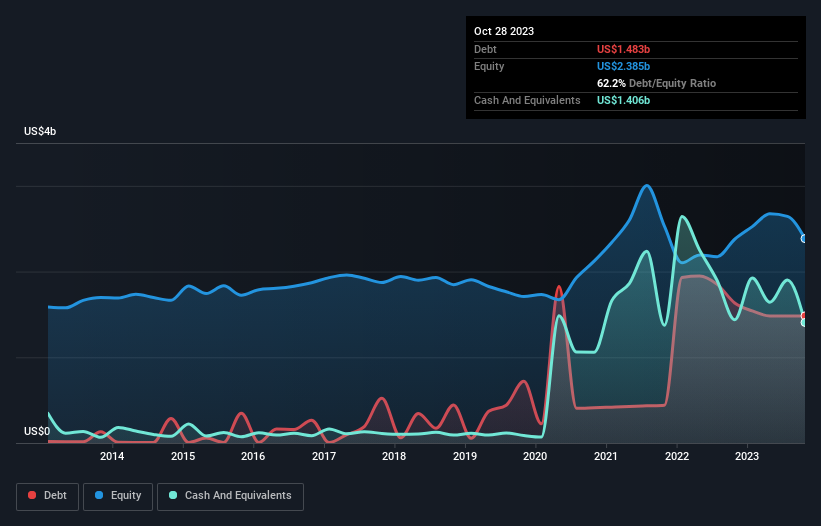
Legendary fund manager Li Lu (who Charlie Munger backed) once said, 'The biggest investment risk is not the volatility of prices, but whether you will suffer a permanent loss of capital.' When we think about how risky a company is, we always like to look at its use of debt, since debt overload can lead to ruin. We can see that DICK'S Sporting Goods, Inc. (NYSE:DKS) does use debt in its business. But is this debt a concern to shareholders?
When Is Debt Dangerous?
Generally speaking, debt only becomes a real problem when a company can't easily pay it off, either by raising capital or with its own cash flow. If things get really bad, the lenders can take control of the business. While that is not too common, we often do see indebted companies permanently diluting shareholders because lenders force them to raise capital at a distressed price. Having said that, the most common situation is where a company manages its debt reasonably well - and to its own advantage. The first thing to do when considering how much debt a business uses is to look at its cash and debt together.
See our latest analysis for DICK'S Sporting Goods
How Much Debt Does DICK'S Sporting Goods Carry?
The image below, which you can click on for greater detail, shows that DICK'S Sporting Goods had debt of US$1.48b at the end of October 2023, a reduction from US$1.63b over a year. However, it also had US$1.41b in cash, and so its net debt is US$76.8m.

A Look At DICK'S Sporting Goods' Liabilities
According to the last reported balance sheet, DICK'S Sporting Goods had liabilities of US$2.99b due within 12 months, and liabilities of US$3.91b due beyond 12 months. On the other hand, it had cash of US$1.41b and US$149.9m worth of receivables due within a year. So its liabilities outweigh the sum of its cash and (near-term) receivables by US$5.34b.
While this might seem like a lot, it is not so bad since DICK'S Sporting Goods has a huge market capitalization of US$11.5b, and so it could probably strengthen its balance sheet by raising capital if it needed to. But we definitely want to keep our eyes open to indications that its debt is bringing too much risk. Carrying virtually no net debt, DICK'S Sporting Goods has a very light debt load indeed.
We use two main ratios to inform us about debt levels relative to earnings. The first is net debt divided by earnings before interest, tax, depreciation, and amortization (EBITDA), while the second is how many times its earnings before interest and tax (EBIT) covers its interest expense (or its interest cover, for short). Thus we consider debt relative to earnings both with and without depreciation and amortization expenses.
With debt at a measly 0.046 times EBITDA and EBIT covering interest a whopping 21.1 times, it's clear that DICK'S Sporting Goods is not a desperate borrower. So relative to past earnings, the debt load seems trivial. On the other hand, DICK'S Sporting Goods's EBIT dived 20%, over the last year. If that rate of decline in earnings continues, the company could find itself in a tight spot. There's no doubt that we learn most about debt from the balance sheet. But ultimately the future profitability of the business will decide if DICK'S Sporting Goods can strengthen its balance sheet over time. So if you're focused on the future you can check out this free report showing analyst profit forecasts.
Finally, a company can only pay off debt with cold hard cash, not accounting profits. So it's worth checking how much of that EBIT is backed by free cash flow. During the last three years, DICK'S Sporting Goods produced sturdy free cash flow equating to 58% of its EBIT, about what we'd expect. This cold hard cash means it can reduce its debt when it wants to.
Our View
Both DICK'S Sporting Goods's ability to to cover its interest expense with its EBIT and its net debt to EBITDA gave us comfort that it can handle its debt. In contrast, our confidence was undermined by its apparent struggle to grow its EBIT. When we consider all the factors mentioned above, we do feel a bit cautious about DICK'S Sporting Goods's use of debt. While debt does have its upside in higher potential returns, we think shareholders should definitely consider how debt levels might make the stock more risky. The balance sheet is clearly the area to focus on when you are analysing debt. But ultimately, every company can contain risks that exist outside of the balance sheet. We've identified 1 warning sign with DICK'S Sporting Goods , and understanding them should be part of your investment process.
At the end of the day, it's often better to focus on companies that are free from net debt. You can access our special list of such companies (all with a track record of profit growth). It's free.
New: Manage All Your Stock Portfolios in One Place
We've created the ultimate portfolio companion for stock investors, and it's free.
• Connect an unlimited number of Portfolios and see your total in one currency
• Be alerted to new Warning Signs or Risks via email or mobile
• Track the Fair Value of your stocks
Have feedback on this article? Concerned about the content? Get in touch with us directly. Alternatively, email editorial-team (at) simplywallst.com.
This article by Simply Wall St is general in nature. We provide commentary based on historical data and analyst forecasts only using an unbiased methodology and our articles are not intended to be financial advice. It does not constitute a recommendation to buy or sell any stock, and does not take account of your objectives, or your financial situation. We aim to bring you long-term focused analysis driven by fundamental data. Note that our analysis may not factor in the latest price-sensitive company announcements or qualitative material. Simply Wall St has no position in any stocks mentioned.
About NYSE:DKS
DICK'S Sporting Goods
Operates as an omni-channel sporting goods retailer primarily in the United States.
Solid track record with excellent balance sheet and pays a dividend.


